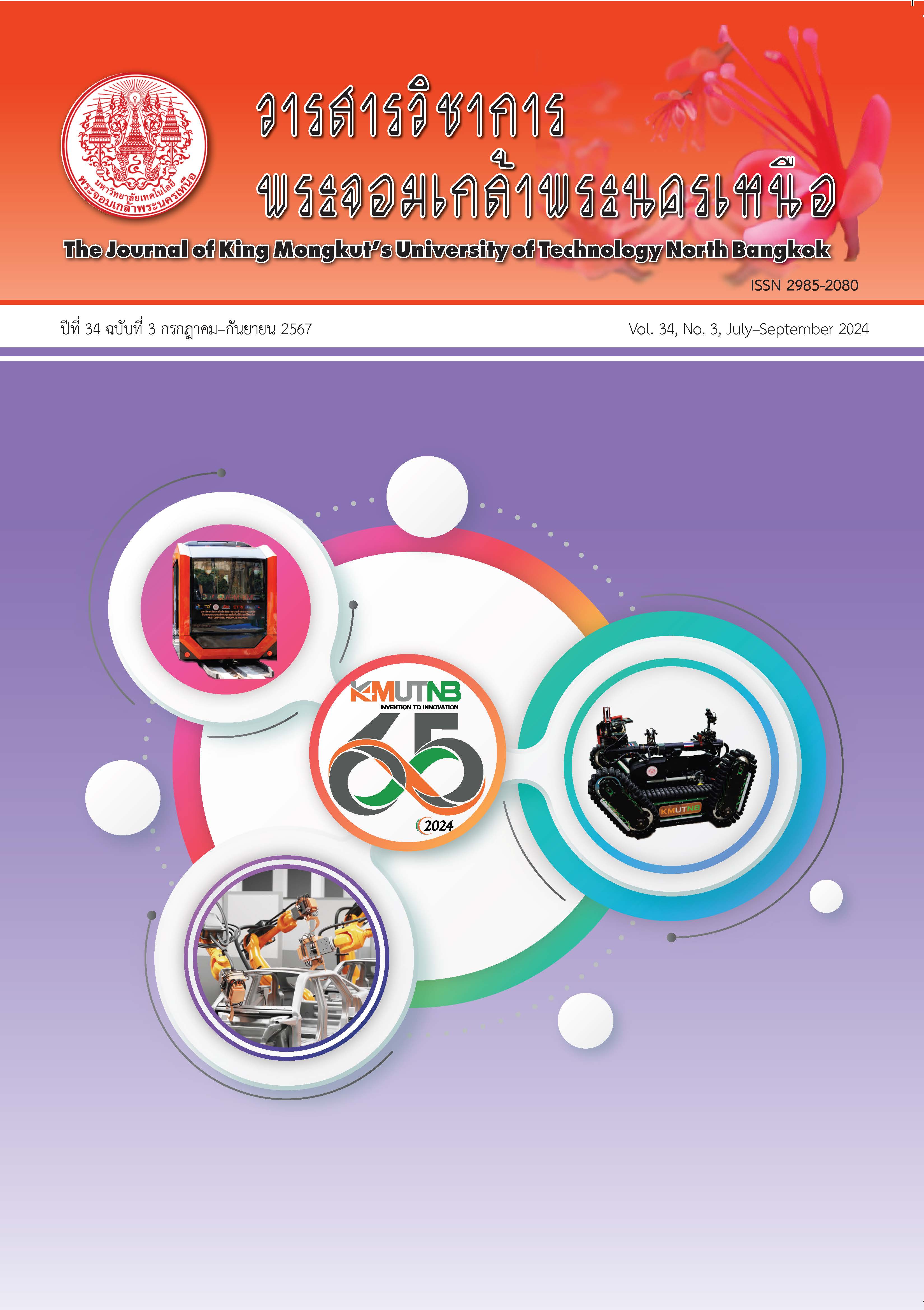กำลังอัดและความทนทานของมอร์ต้าที่ใช้เถ้าปาล์มน้ำมันบดละเอียดเป็นวัสดุปอซโซลานที่สัมผัสสภาพแวดล้อมที่เป็นกรดบริเวณพื้นที่พรุ
Main Article Content
บทคัดย่อ
งานวิจัยนี้มุ่งศึกษากำลังอัด การสูญเสียกำลังอัด การสูญเสียน้ำหนัก และการขยายตัวของมอร์ต้าที่สัมผัสสภาพแวดล้อมที่เป็นกรดบริเวณพื้นที่พรุในพื้นที่จังหวัดนราธิวาส เถ้าปาล์มน้ำมันซึ่งเป็นวัสดุเหลือทิ้งจากโรงงานผลิตน้ำมันปาล์มมาใช้แทนที่ปูนซีเมนต์ปอร์ตแลนด์ประเภทที่ 1 บางส่วนในส่วนผสมของมอร์ต้า โดยนำเถ้าปาล์มน้ำมันบดละเอียดแทนที่ปูนซีเมนต์ปอร์ตแลนด์ในอัตราส่วนร้อยละ 25 35 50 และ 65 โดยน้ำหนักของปูนซีเมนต์ ผลการศึกษาพบว่า การใช้เถ้าปาล์มน้ำมันบดละเอียดส่งผลให้การพัฒนากำลังอัดของมอร์ต้าที่สัมผัสสภาพแวดล้อมที่เป็นกรดในพื้นที่พรุมีแนวโน้มที่ดีขึ้น โดยเฉพาะอย่างยิ่งการใช้เถ้าปาล์มน้ำมันบดละเอียดแทนที่ปูนซีเมนต์ปอร์ตแลนด์ในอัตราส่วนร้อยละ 25 โดยน้ำหนักของปูนซีเมนต์ สามารถพัฒนากำลังอัดให้มีค่าสูงกว่ามอร์ต้าควบคุมที่สัมผัสสภาพแวดล้อมที่เป็นกรดในพื้นที่พรุตั้งแต่อายุ 7 วันขึ้นไป โดยมอร์ต้ามีค่ากำลังอัดที่อายุ 7 28 60 และ 90 วัน คิดเป็นร้อยละ 108 108 106 และ 109 ของคอนกรีตควบคุม ตามลำดับ เมื่อพิจารณาความทนทานของมอร์ต้าที่สัมผัสสภาพแวดล้อมที่เป็นกรดในพื้นที่พรุพบว่า การใช้เถ้าปาล์มน้ำมันบดละเอียดแทนที่ปูนซีเมนต์ปอร์ตแลนด์ในอัตราส่วนไม่เกินร้อยละ 35 โดยน้ำหนักของปูนซีเมนต์ สามารถช่วยลดการสูญเสียกำลังอัดและสูญเสียน้ำหนักของมอร์ต้าได้ นอกจากนี้การใช้เถ้าปาล์มน้ำมันบดละเอียดแทนที่ปูนซีเมนต์ปอร์ตแลนด์ไม่เกินร้อยละ 65 โดยน้ำหนักของปูนซีเมนต์ สามารถช่วยลดการขยายตัวของมอร์ต้าได้ และให้ผลที่ดีกว่าเมื่อเปรียบเทียบกับมอร์ต้าควบคุม จะเห็นได้ว่าการใช้เถ้าปาล์มน้ำมันบดละเอียดแทนที่ปูนซีเมนต์ปอร์ตแลนด์ในอัตราส่วนไม่เกินร้อยละ 35 โดยน้ำหนักของปูนซีเมนต์ สามารถช่วยลดการสูญเสียกำลังอัด การสูญเสียน้ำหนัก และการขยายตัวของมอร์ต้าที่สัมผัสสภาพแวดล้อมที่เป็นกรดในพื้นที่พรุ และให้ผลที่ดีกว่าเมื่อเปรียบเทียบกับมอร์ต้าควบคุม ตลอดจนสามารถช่วยลดปริมาณปูนซีเมนต์ในส่วนผสมของมอร์ต้าส่งผลให้ช่วยลดค่าใช้จ่ายในการผลิตและเป็นมิตรต่อสิ่งแวดล้อม
Article Details

อนุญาตภายใต้เงื่อนไข Creative Commons Attribution-NonCommercial-NoDerivatives 4.0 International License.
บทความที่ลงตีพิมพ์เป็นข้อคิดเห็นของผู้เขียนเท่านั้น
ผู้เขียนจะต้องเป็นผู้รับผิดชอบต่อผลทางกฎหมายใดๆ ที่อาจเกิดขึ้นจากบทความนั้น
เอกสารอ้างอิง
TCMA. (2021, September 20). Activity report 2020. TCMA. Bangkok, Thailand. [Online]. (in Thai). Available: https://drive.google.com/ file/d/1za17MctUpGRNJmWgFLckrRaXAV0CFb lZ/view
L. K. Turner and F. G. Collins, “Carbon dioxide equivalent (CO2-e) emissions: A comparison between geopolymer and OPC cement concrete,” Construction and Building Materials, vol. 43, pp. 125–130, 2013.
OAE. (2021, September, 20). Palm oil product statistics year 2019. OAE. Bangkok, Thailand. [Online]. (in Thai). Available: https://www.oae. go.th/assets/portals/1/fileups/prcaidata/files/ oilpalm%2062.pdf
W. Tangchirapat, C. Jaturapitakkul, and K. Kiattikomol, “Compressive strength and expansion of blended cement mortar containing palm oil fuel ash,” Journal of Materials in Civil Engineering, vol. 21, no. 8, pp. 426-431, 2009.
W. Tangchirapat, J. Tangpakasit, S. Waew-kum, and C. Jaturapitakkul, “A new pozzolanic material from palm oil fuel ash,” KMUTT Research and Development Journal, vol. 26, no. 4, pp. 459–474, 2003 (in Thai).
M. Safiuddin, M. Abdus Salam, and M. Z. Jumaat, “Utilization of palm oil fuel ash in concrete: a review,” Journal of Construction Engineering and Management, vol. 17, no. 2, pp. 234–247, 2011.
L. Ponhsampatea, T. Cheewaket, and W. Chalee, “Chloride penetration and steel corrosion of concrete containing palm oil fuel ash under 5-year exposure in marine environment,” The Journal of KMUTNB, vol. 28, no. 1, pp. 23–36, 2018 (in Thai).
R. Noraini, G. Seca, I. Johan, and I. J. Mohd, “Comparative study of water quality at different peat swamp forest of Batang Igan, Sibu Sarawak," American Journal of Environmental Sciences, vol. 6, no. 5, pp. 416–421, 2010.
Y. S. D. Satya, E. Saputra, and M. Olivia, “Performance of blended fly ash (FA) and palm oil fuel ash (POFA) geopolymer mortar in acidic peat environment,” Materials Science Forum, vol. 841, pp. 83–89, 2016.
M. Wijaya, M. Olivia, G. Wibisono, E. Saputra, and S. Wang, “Characteristics of geopolymer hybrid concrete in peat water,” IOP Conference Series: Materials Science and Engineering, vol. 615, pp. 1–9, 2019.
V. Sata, A. Sathonsaowaphak, and P. Chindaprasirt, “Resistance of lignite bottom ash geopolymer mortar to sulfate and sulfuric acid attack,” Cement and Concrete Composites, vol. 34, no. 5, pp. 700–708, 2012.
M. A. Ismail and C. B. Feng, “The effect of acidic environment on the concrete utilizing palm oil fuel ash,” IOP Conference Series: Materials Science and Engineering, vol. 495, pp. 1–12, 2019.
M. W. Hussin, M. A. Ismail, A. Budiea, and K. Muthusamy, “Durability of high strength concrete containing palm oil fuel ash of different fineness,” Malaysian Journal of Civil Engineering, vol. 21, no. 2, pp. 180–194, 2009.
Test Method for Flow of Hydraulic Cement Mortar, ASTM Standards C1437, 2020.
Standard test method for fineness of hydraulic cement by the 45-μm (No. 325) Sieve, ASTM Standards C430, 2017.
Standard test method for density of hydraulic cement, ASTM Standards C188, 2017.
Standard test method for compressive strength of hydraulic cement mortars (Using 2-in. or [50 mm] cube specimens), ASTM Standards C109M, 2021.
Standard practice for use of apparatus for the determination of length change of hardened cement paste, mortar, and concrete, ASTM Standards C490M, 2017.
W. Tangchirapat, S. Khamklai, and C. Jaturapitakkul, “Use of ground palm oil fuel ash to improve strength, sulfate resistance, and water permeability of concrete containing high amount of recycled concrete aggregates,” Materials and Design, vol. 41, pp. 150–157, 2012.
W. Sanawung, T. Cheewaket, W. Tangchirapat, and C. Jaturapitakkul, “Influence of palm oil fuel ash and W/B ratios on compressive strength, water permeability, and chloride resistance of concrete,” Advances in Materials Science and Engineering, vol. 2017, pp. 1–8, 2017.
V. Sata, C. Jaturapitakkul, and K. Kiattikomol, “Utilization of palm oil fuel ash in highstrength concrete,” Journal of Materials in Civil Engineering, vol. 16, no. 6, pp. 623–628, 2004.
N. Makaratat, C. Rattanashotinunt, , W. Tangchirapat, C. Jaturapitakkul, and K. Manaputtananukul, “Properties of concrete made from industrial wastes containing calcium carbide residue palm oil fuel ash rice husk-bark ash and recycled aggregates,” The Journal of Industrial Technology, vol. 12, no. 3, pp. 37–52, 2016 (in Thai).
Palm oil ash for use as an admixture in concrete, Thai Industrial Standards Institute TIS 2888, 2018 (in Thai).
J. Tangpagasit, R. Cheerarot, C. Jaturapitakkul, and K. Kiattikomol, “Packing effect and pozzolanic reaction of fly ash in mortar,” Cement and Concrete Research, vol. 35, no. 6, pp. 1145–1151, 2005.
W. Tangchirapat, R. Buranasing, C. Jaturapitakkul, and P. Chindaprasirt, “Influence of rice husk– bark ash on mechanical properties of concrete containing high amount of recycled aggregates,” Construction and Building Materials, vol. 22, no. 8, pp. 1812–1819, 2008.
B. Chatveera and P. Lertwattanaruk, “Evaluation of nitric and acetic acid resistance of cement mortars containing high-volume black rice husk ash," Journal of Environmental Management, vol. 133, pp. 365–373, 2014.
S. Sahoo, P. K. Parhi, and B. C. Panda, “Durability properties of concrete with silica fume and rice husk ash,” Cleaner Engineering and Technology, vol. 2, pp. 1–10, 2021.
K. Muthusamy, N. Zamri, I. Mohd Haniffa, N. N. Sarbini, and F. Mat Yahaya, “Acid resistance of oil palm shell lightweight aggregate concrete containing palm oil fuel ash,”Applied Mechanics and Materials, vol. 754–755, pp. 326–330, 2015.

